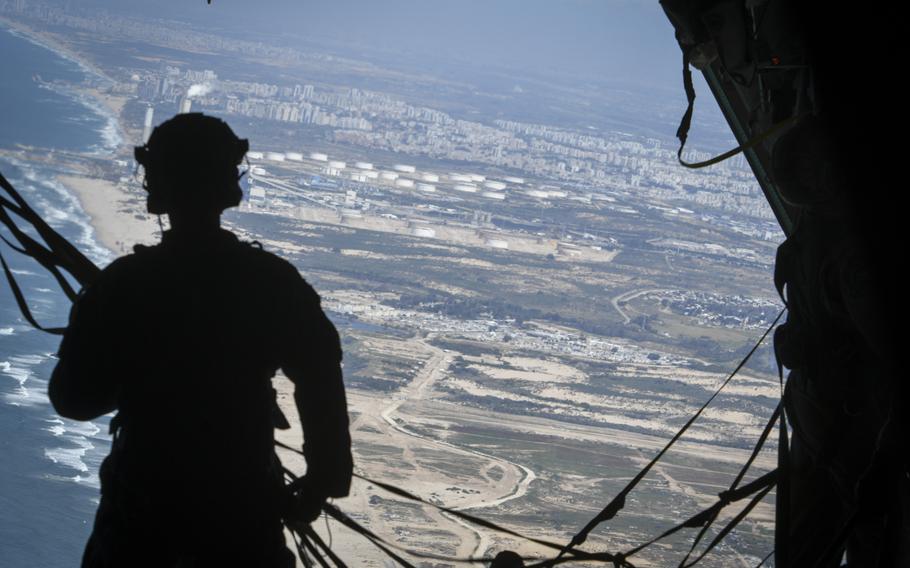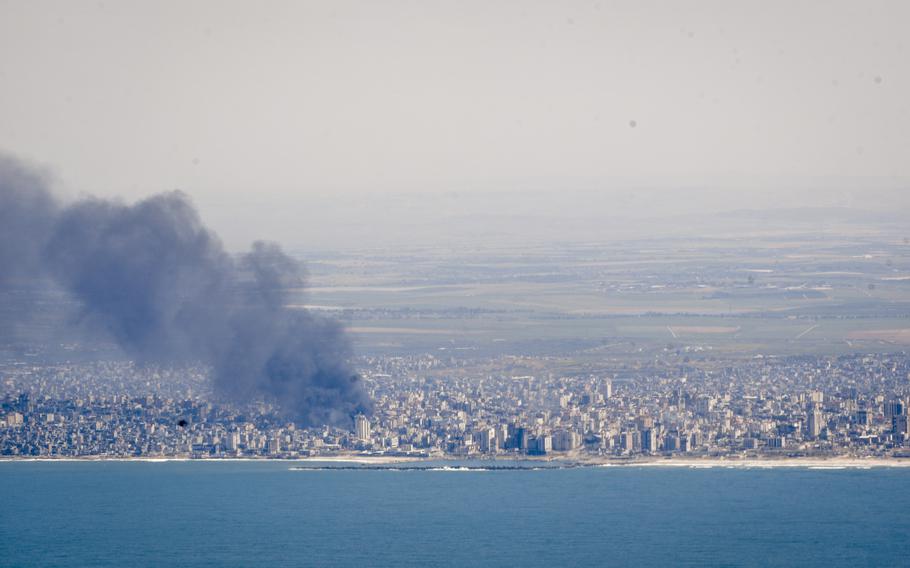
An airman looks out over the Mediterranean Sea during an airdrop of humanitarian aid from a U.S. Air Force C-130 cargo plane into northern Gaza on Wednesday, March 20, 2024. (J.P. Lawrence/Stars and Stripes)
OVER THE GAZA STRIP — The U.S. airmen aboard a C-130 cargo plane stole glances at the billowing black smoke and collapsed buildings below them, as they prepared to airdrop three tons of humanitarian aid.
Their mission Wednesday into the northern Gaza Strip was the U.S. military’s 14th airdrop of aid into what was once the territory’s largest population center.
Witnessing the scenes of devastation is eye-opening, said Lt. Col. Jeremy Anderson, airborne mission commander for Wednesday’s airdrop.
“It hits home for a lot of the air crew, when they look out and they see firsthand the environment that they are providing aid to,” said Anderson, who has flown on five missions to airdrop aid to Gaza since the beginning of March.
American officials say that the airdrops do help, while conceding that they won’t alleviate much of the need in Gaza.
More than 2 million people are estimated to be displaced by the war that began Oct. 7, when a Hamas terrorist attack killed 1,200 people in Israel. Gaza health authorities estimate the number of dead in the territory at more than 30,000 people, a figure that does not distinguish between bystanders and combatants.
The plane on Wednesday flew from Jordan across the West Bank, into Israel and then over the Mediterranean Sea, before approaching Gaza. Along for the mission were two MQ-9 Reaper drones. The drops are monitored through drone feeds and evaluated for problems with the landing, military officials said.
The U.S. mission Wednesday came amid parallel airdrop missions by Jordan, Egypt, Germany and Singapore. More countries are expected to contribute in the coming weeks.
On the American C-130 were 16 pallets carrying Jordanian-supplied rice, flour, milk, pasta and canned foods. The pallets were topped by Jordanian parachutes, which are designed for people, but can slow the pallets enough to prevent injuries to people on the ground.
Other American aid missions to Gaza have used C-17 Globemaster IIIs, which can carry more weight, flying out of Al Udeid Air Base in Qatar. These flights drop pallets of American military rations and water bottles.
The airdrops are “woefully insufficient” but better than nothing, said Alex Plitsas, a senior fellow with the Washington-based Atlantic Council.
But until the U.S. readies a temporary pier that could provide as many as 2 million meals a day, “air drops are a way of showing you’re doing something,” said Plitsas, an Army veteran, during a phone interview Wednesday.
Asked about whether these pallets of aid might inadvertently benefit Hamas and other terrorist groups, U.S. officials said they hope the supplies find their way to the civilians desperately short of food after months of intense ground combat.
Anderson, the airborne mission commander for Wednesday’s airdrop, said the areas where these pallets land can’t be called drop zones, because that implies that there are trusted personnel on the ground to receive them.
But he said air crews use electro-optic infrared sensors to make sure there are no people where the bundles are supposed to land.
Over Gaza, the back door of the plane opened. As the aircraft slowed to about 160 mph, the bundles rolled out of the back of the plane. All the parachute canopies opened and loose pieces of cardboard scattered into the sky like confetti.
The door remained open as airmen looked out over the city, the aid bundles with their parachutes appearing smaller and smaller as they drifted downward.
“Honestly, it’s a little bit, but we do what we can,” Anderson said. “We’ll continue to maximize what’s in our control, and what’s in our control is airdropping.”

A plume of black smoke billows from near the Al Shifa hospital in Gaza City as seen from the cockpit of a U.S. Air Force C-130 cargo plane approaching for a humanitarian airdrop mission on Wednesday, March 20, 2024. (J.P. Lawrence/Stars and Stripes)